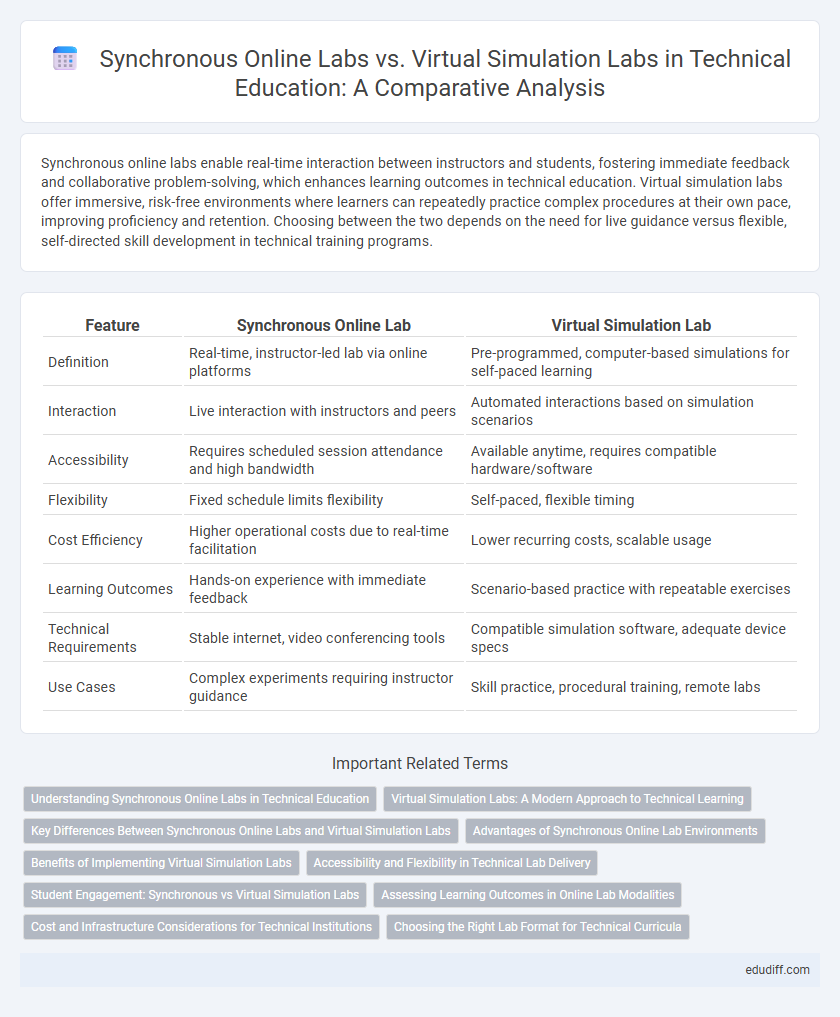Synchronous online labs enable real-time interaction between instructors and students, fostering immediate feedback and collaborative problem-solving, which enhances learning outcomes in technical education. Virtual simulation labs offer immersive, risk-free environments where learners can repeatedly practice complex procedures at their own pace, improving proficiency and retention. Choosing between the two depends on the need for live guidance versus flexible, self-directed skill development in technical training programs.
Table of Comparison
| Feature | Synchronous Online Lab | Virtual Simulation Lab |
|---|---|---|
| Definition | Real-time, instructor-led lab via online platforms | Pre-programmed, computer-based simulations for self-paced learning |
| Interaction | Live interaction with instructors and peers | Automated interactions based on simulation scenarios |
| Accessibility | Requires scheduled session attendance and high bandwidth | Available anytime, requires compatible hardware/software |
| Flexibility | Fixed schedule limits flexibility | Self-paced, flexible timing |
| Cost Efficiency | Higher operational costs due to real-time facilitation | Lower recurring costs, scalable usage |
| Learning Outcomes | Hands-on experience with immediate feedback | Scenario-based practice with repeatable exercises |
| Technical Requirements | Stable internet, video conferencing tools | Compatible simulation software, adequate device specs |
| Use Cases | Complex experiments requiring instructor guidance | Skill practice, procedural training, remote labs |
Understanding Synchronous Online Labs in Technical Education
Synchronous online labs in technical education enable real-time interaction between instructors and students, facilitating immediate feedback and collaborative problem-solving. These labs mimic traditional hands-on experiences through live demonstrations, remote equipment access, and simultaneous participation, enhancing practical skills development. In contrast, virtual simulation labs provide self-paced, computer-generated environments that emphasize concept reinforcement but lack the dynamic engagement of synchronous sessions.
Virtual Simulation Labs: A Modern Approach to Technical Learning
Virtual simulation labs utilize advanced software to create immersive, interactive environments replicating real-world technical scenarios, enhancing hands-on learning without physical constraints. These labs offer scalable, cost-effective solutions that enable repeated practice and immediate feedback, crucial for mastering complex technical skills. Integration of real-time data analytics and adaptive learning algorithms tailors experiences to individual learners, promoting deeper understanding and retention.
Key Differences Between Synchronous Online Labs and Virtual Simulation Labs
Synchronous online labs require real-time interaction between instructors and students, allowing for immediate feedback and collaborative problem-solving, while virtual simulation labs provide autonomous, self-paced learning through interactive software environments. Virtual simulation labs emphasize flexibility and accessibility, often incorporating realistic scenarios and data modeling, whereas synchronous labs focus more on guided instruction and direct supervision. The choice between these formats depends on the pedagogical goals, with synchronous labs supporting structured learning and simulations enhancing experiential, adaptive practice.
Advantages of Synchronous Online Lab Environments
Synchronous online lab environments offer real-time interaction between instructors and students, enabling immediate feedback and collaborative problem-solving that enhances the learning experience. These labs simulate hands-on activities closely, allowing learners to ask questions, clarify concepts instantly, and engage in live discussions that foster deeper understanding. The structured schedule and direct communication available in synchronous labs improve student accountability and motivation compared to asynchronous virtual simulation labs.
Benefits of Implementing Virtual Simulation Labs
Virtual simulation labs offer scalable access to complex experiments without the constraints of physical equipment or geography, allowing learners to engage anytime and anywhere. They enhance safety by eliminating risks associated with hazardous materials and provide real-time data analytics for personalized feedback and assessment. Cost efficiency is improved through reduced facility maintenance and resource consumption, making virtual labs an effective solution for remote and hybrid education models.
Accessibility and Flexibility in Technical Lab Delivery
Synchronous online labs require real-time participation, limiting accessibility for students with varying schedules or time zones, whereas virtual simulation labs offer on-demand access, enhancing flexibility by allowing learners to engage with technical content anytime. Virtual simulations can be accessed across multiple devices without the need for specialized equipment, improving accessibility for remote or resource-constrained users. Technical courses benefit from virtual labs by accommodating diverse learner needs and providing scalable, flexible environments that do not depend on simultaneous instructor presence.
Student Engagement: Synchronous vs Virtual Simulation Labs
Synchronous online labs enhance student engagement through real-time interaction, immediate feedback, and collaborative problem-solving, fostering a dynamic learning environment. Virtual simulation labs offer flexible, self-paced engagement with immersive scenarios that allow repeated practice and skill mastery. Both modalities improve learning outcomes, but synchronous labs excel in promoting active participation and peer communication.
Assessing Learning Outcomes in Online Lab Modalities
Synchronous online labs enable real-time interaction between instructors and students, facilitating immediate feedback and dynamic assessment of learning outcomes through live demonstrations and Q&A sessions. Virtual simulation labs provide immersive, self-paced environments where learners can repeatedly practice tasks, with embedded analytics tracking progress and competency development. Combining synchronous labs with simulation data enhances the accuracy of evaluating skill acquisition and conceptual understanding in online learning modalities.
Cost and Infrastructure Considerations for Technical Institutions
Synchronous online labs require real-time interaction infrastructure such as high-speed internet and reliable servers, leading to higher initial setup and maintenance costs compared to virtual simulation labs. Virtual simulation labs reduce physical hardware expenses and allow scalable access via cloud platforms, minimizing infrastructure overhead for technical institutions. Cost efficiency in virtual labs results from lower space requirements and the ability to update software centrally without extensive physical upgrades.
Choosing the Right Lab Format for Technical Curricula
Synchronous online labs provide real-time interaction and immediate feedback, crucial for hands-on technical skill development and collaborative problem-solving in complex engineering tasks. Virtual simulation labs offer scalable, risk-free environments ideal for repetitive practice and mastering theoretical concepts without physical resource constraints. Selecting between these formats depends on curriculum goals: prioritize synchronous labs for skill application and teamwork, while virtual simulations suit foundational learning and conceptual experiments.
Synchronous online lab vs Virtual simulation lab Infographic

 edudiff.com
edudiff.com